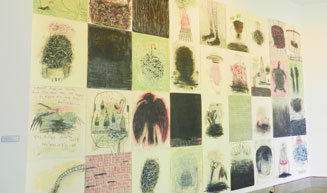
Childlike drawings containing rounded monsters and cartoon aliens fill the main space of the Triton Museum of Art. Messages of corruption and consumption accompany the art of Heather Wilcoxon in her exhibit entitled Loaded.
One of Wilcoxon’s most striking pieces is a compilation of 36 oil and graphite on paper drawings titled 36 Sludge Drawings. Wilcoxon explains the message in a statement hanging on the wall next to the art display. “This experience [the oil spill in May-August of 2010] also made me realize we are all part of the problem. Our human consumption is killing our planet.”
Among the 36 drawings is a black bird outlined in red and a turtle on a light red background, quite possibly portraying the death and destruction of animals and wildlife during oil spills and a statement piece that says, “Petroleum products. Gasoline that run (sic) our cars, airplanes, boats, ships, buses, spaceships. Race cars, motorcycles, bulldozers, trackters (sic), lawnmowers. All plastic tables. Bags, bottles, toys, computers, T.V.’s (sic), radio’s (sic), car parts, foam for our beds, Styrofoam cups, plates, plastic forks, knives, spoons, chairs, tables, floors, plants, pots, buckets, food containers, hair brushes, baby dypers (sic), benches, kitchen appliances, fax machines, Zerox (sic) machines, latex gloves, shoes, books, cooling fans, heaters, hair clips, candy rappers (sic) and the list goes on and on. There is an island the size of Texas in the Pacific that is entirely made of plastic garbage and several more growing. All petroleum suffocating our oceans.”
Those who may not find interest in Wilcoxon’s art, or art making a statement about our way of life, may find Jamie Brunson’s Indra’s Net pieces more palatable.
“I chose lattices and veils as forms to represent the experience because they’re the closest visual analogues I could find [to Kundalini, an open eye meditation based on rhythmic, cyclical breathing]…In this body of work, I’ve taken a process-oriented approach, using the physical qualities of patint to mimic perceptual phenomena – blurring, overlapping, dissolving edges and radience – that come from meditation,” said Brunson in a prepared statement.
Nature’s influence on Brunson’s works is clearly seen throughout her exhibit, which uses mostly softer colors – pinks, greens, and oranges – throughout. Streams, flowers, grass, and web-like honeycombs are found within Brunson’s pieces.
In Gather, a pink, wax on polyester over panel, oil, and alkyd painting, wavy lines fill the canvas. Within seconds of looking at the piece, one can clearly see the movement, almost like blades of grass swaying in a light springtime breeze, Brunson intended.
Another artist influenced by nature on display at the Triton is Kenjilo Nano. Nano’s oil and silver leaf on canvas exhibit, Pacific Paintings: 1986-2011, contains many thick, almost runny brush strokes and an abstract feel. However, in a short bio about Nano’s work, it is clarified that Nano is not strictly an abstractionist, but that his works include elements of realism.
One piece in particular is called out in the artist’s information, Yellow Field V. “Yellow Field V (2006) bathes our view with broad washes of ephemeral yellow, but it is dashed with horizontal lines giving the work a sense of movement and physicality Heaven and Earth – or the transcendent and physical if you will – meet and coalesce, ultimately eliminating such distinctions. It is as if we are invited to find ourselves in an amorphous harmony to ignite our internal reflections, but not daring to leave us stagnant, Nano nudges us along our way with the flowing movement of the lines. A box-like window interrupts both stasis field and movements, reminding us as always, to look deeper. Set against the ever-expanding fields of color – only artificially boundaried by the edge of the canvas.”
All three artists’ works are on display for a limited time, with Brunson’s and Nano’s shows closing this Sunday, November 20 and Wilcoxon’s show ending the following weekend.
The Triton Museum of Art focuses primarily on artists of the Greater Bay Area and is at 1505 Warburton Ave. in Santa Clara. The museum open Tuesday through Saturday from 11 a.m. to 5 p.m. and Sunday from noon to 4 p.m. It is also open the third Thursday of every month until 8 p.m. and is closed Mondays and holidays. Admission to the Triton is free. For more information visit www.tritonmuseum.org.





